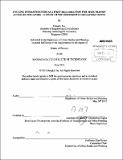| dc.contributor.advisor | P. Christopher Zegras. | en_US |
| dc.contributor.author | Tay, Hengky | en_US |
| dc.contributor.other | Massachusetts Institute of Technology. Dept. of Urban Studies and Planning. | en_US |
| dc.coverage.spatial | a-si--- | en_US |
| dc.date.accessioned | 2012-10-10T15:46:25Z | |
| dc.date.available | 2012-10-10T15:46:25Z | |
| dc.date.copyright | 2012 | en_US |
| dc.date.issued | 2012 | en_US |
| dc.identifier.uri | http://hdl.handle.net/1721.1/73799 | |
| dc.description | Thesis (S.M.)--Massachusetts Institute of Technology, Dept. of Urban Studies and Planning, 2012. | en_US |
| dc.description | Cataloged from PDF version of thesis. | en_US |
| dc.description | Includes bibliographical references (p. 126-127). | en_US |
| dc.description | The first and last mile problem of public transport is an area of growing research interest as cities confront challenges to improve public transport alternatives to support urban activities. First and last mile solutions such as cycling are becoming increasingly popular in many cities around the world as a cheap and environmentally friendly solution. Investments in bicycling infrastructure provide cyclists and potential cyclists a safer environment to cycle to work and to public transit nodes. Singapore is also rolling out its National Cycling Plan with dedicated bike paths in residential towns and bicycle parking lots at Mass Rapid Transit (MRT) stations, hoping to use cycling as a potential first mile solution to encourage more people to cycle as a feeder mode for public transport. This thesis provides a preliminary investigation of bike infrastructures as a first mile solution by examining MRT ridership during morning peak hours. A multivariate regression model predicts MRT ridership as a function of bike infrastructure variables, controlling for other modes of access, built environment characteristics, and socio-economic and demographic factors. The models find that bike paths connecting to and bike lots located at MRT stations in Singapore are statistically insignificant in explaining MRT ridership variation. This could be due to the infancy of the bike infrastructure resulting in poor bike-to-transit usage. However, a 'porousness' measure of walkability near the stations was significant. While there are limitations on the data and shortcomings in the approach, this research identifies many potential areas of further investigation into the first and last mile problem of public transport. | en_US |
| dc.description.statementofresponsibility | by Hengky Tay. | en_US |
| dc.format.extent | 127 p. | en_US |
| dc.language.iso | eng | en_US |
| dc.publisher | Massachusetts Institute of Technology | en_US |
| dc.rights | M.I.T. theses are protected by
copyright. They may be viewed from this source for any purpose, but
reproduction or distribution in any format is prohibited without written
permission. See provided URL for inquiries about permission. | en_US |
| dc.rights.uri | http://dspace.mit.edu/handle/1721.1/7582 | en_US |
| dc.subject | Urban Studies and Planning. | en_US |
| dc.title | Cycling infrastructure as a first mile solution for mass transit access in Singapore : a study of MRT ridership in Singapore towns | en_US |
| dc.title.alternative | Study of MRT ridership in Singapore towns | en_US |
| dc.type | Thesis | en_US |
| dc.description.degree | S.M. | en_US |
| dc.contributor.department | Massachusetts Institute of Technology. Department of Urban Studies and Planning | |
| dc.identifier.oclc | 811139796 | en_US |
